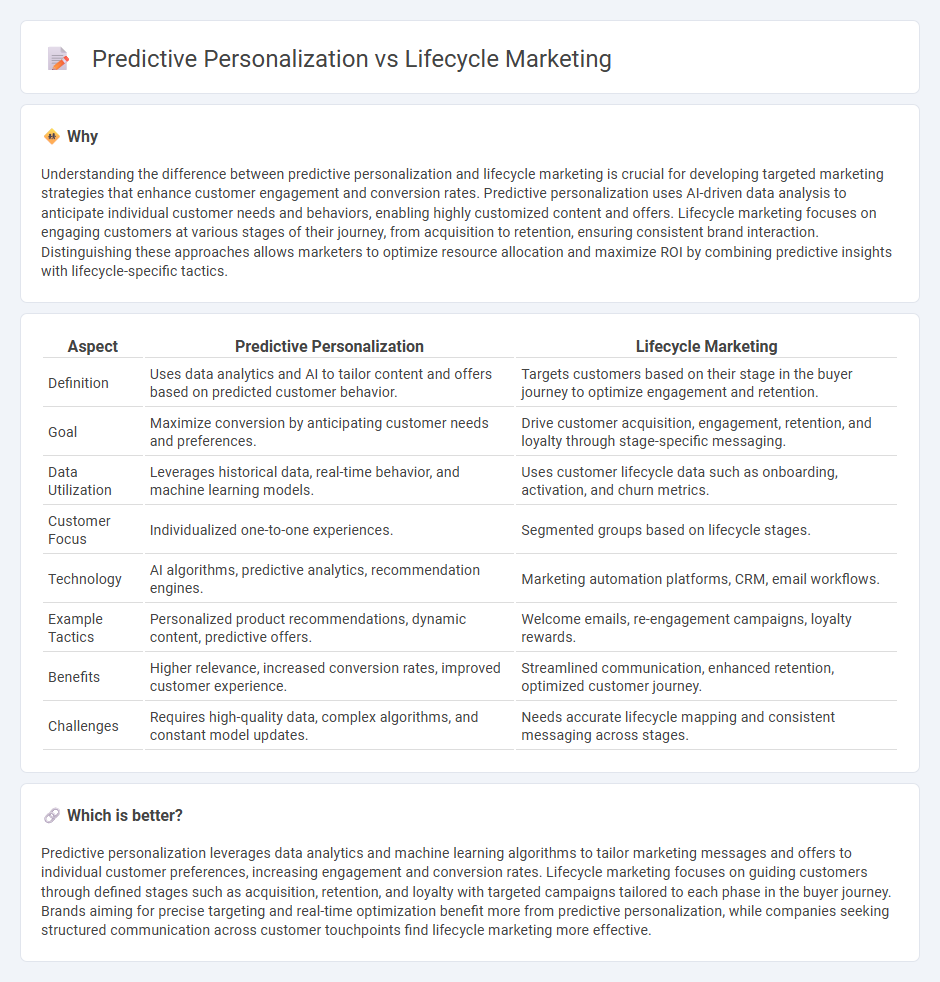
Predictive personalization leverages advanced data analytics and machine learning algorithms to anticipate individual customer needs and tailor marketing messages accordingly. Lifecycle marketing focuses on strategically engaging customers at every stage of their journey, from awareness to retention, optimizing interactions to enhance loyalty and conversion rates. Discover how integrating predictive personalization with lifecycle marketing can revolutionize your customer engagement strategies.
Why it is important
Understanding the difference between predictive personalization and lifecycle marketing is crucial for developing targeted marketing strategies that enhance customer engagement and conversion rates. Predictive personalization uses AI-driven data analysis to anticipate individual customer needs and behaviors, enabling highly customized content and offers. Lifecycle marketing focuses on engaging customers at various stages of their journey, from acquisition to retention, ensuring consistent brand interaction. Distinguishing these approaches allows marketers to optimize resource allocation and maximize ROI by combining predictive insights with lifecycle-specific tactics.
Comparison Table
| Aspect | Predictive Personalization | Lifecycle Marketing |
|---|---|---|
| Definition | Uses data analytics and AI to tailor content and offers based on predicted customer behavior. | Targets customers based on their stage in the buyer journey to optimize engagement and retention. |
| Goal | Maximize conversion by anticipating customer needs and preferences. | Drive customer acquisition, engagement, retention, and loyalty through stage-specific messaging. |
| Data Utilization | Leverages historical data, real-time behavior, and machine learning models. | Uses customer lifecycle data such as onboarding, activation, and churn metrics. |
| Customer Focus | Individualized one-to-one experiences. | Segmented groups based on lifecycle stages. |
| Technology | AI algorithms, predictive analytics, recommendation engines. | Marketing automation platforms, CRM, email workflows. |
| Example Tactics | Personalized product recommendations, dynamic content, predictive offers. | Welcome emails, re-engagement campaigns, loyalty rewards. |
| Benefits | Higher relevance, increased conversion rates, improved customer experience. | Streamlined communication, enhanced retention, optimized customer journey. |
| Challenges | Requires high-quality data, complex algorithms, and constant model updates. | Needs accurate lifecycle mapping and consistent messaging across stages. |
Which is better?
Predictive personalization leverages data analytics and machine learning algorithms to tailor marketing messages and offers to individual customer preferences, increasing engagement and conversion rates. Lifecycle marketing focuses on guiding customers through defined stages such as acquisition, retention, and loyalty with targeted campaigns tailored to each phase in the buyer journey. Brands aiming for precise targeting and real-time optimization benefit more from predictive personalization, while companies seeking structured communication across customer touchpoints find lifecycle marketing more effective.
Connection
Predictive personalization leverages data analytics and machine learning to anticipate customer needs, enabling tailored marketing messages that enhance engagement throughout the customer journey. Lifecycle marketing uses these insights to deliver timely, relevant content at each stage--from awareness to retention--maximizing conversion rates and customer loyalty. By integrating predictive analytics into lifecycle strategies, marketers optimize resource allocation and improve overall campaign performance.
Key Terms
**Lifecycle Marketing:**
Lifecycle marketing strategically targets customers at each stage of their journey, from acquisition to retention and advocacy, by delivering tailored content that nurtures ongoing engagement. This approach leverages data segmentation, email campaigns, and behavior-triggered messaging to maximize customer lifetime value and reduce churn rates. Explore more to understand how lifecycle marketing can transform your customer relationships and drive sustainable growth.
Customer Journey
Lifecycle marketing maps each stage of the customer journey from awareness to loyalty, tailoring content and offers to meet evolving needs and increase retention; predictive personalization uses AI-driven data analytics to anticipate customer behavior and deliver hyper-relevant experiences in real-time. Integrating lifecycle marketing with predictive personalization maximizes engagement by aligning timely messaging with individual preferences and predicted actions throughout the journey. Explore how combining these strategies can revolutionize your customer experience and drive higher conversion rates.
Segmentation
Lifecycle marketing segments customers based on their stage in the buying journey, enabling tailored messaging that nurtures leads from awareness to retention. Predictive personalization uses machine learning algorithms to analyze behavioral data and predict future actions, creating dynamic segments for highly targeted experiences. Discover how combining these approaches can revolutionize your segmentation strategy.
Source and External Links
What is Lifecycle Marketing? A Deep Dive for Marketing Managers - Lifecycle marketing is a strategy that engages customers with timely, relevant messages at each stage of their interaction with a brand to build loyalty and increase lifetime value, using triggers, personalized messaging, and optimal communication channels.
Why Growth Marketers Can't Live Without Lifecycle Marketing - Braze - Lifecycle marketing delivers tailored content and experiences based on where customers are in their journey, leveraging data insights to nurture relationships, improve marketing performance, and drive sustainable business growth.
Drive Business Growth with Customer Lifecycle Marketing - Mailchimp - Lifecycle marketing segments customers by their stage in the journey and applies specific strategies to attract, convert, retain, and reactivate them, thus driving growth effectively by tailoring approaches to different customer needs over time.
 dowidth.com
dowidth.com